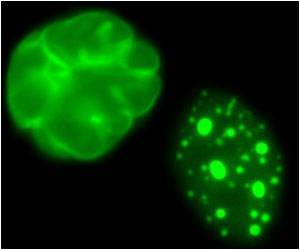Highlights
- Progeria (premature aging) is a rare aging disease affecting fewer than 400 people worldwide
- Premature death in progeria is related to cardiovascular problems
- Altered connexin 43 protein expression in progeria patients increases risk of arrhythmias (abnormal heart rhythms)
Progeria affects 1 in 20 million people
It affects both sexes equally and all races.
Progeria is a rare genetic disease and is caused by a mutation in the gene coding laminin A (LMNA) protein which is the structural scaffolding that holds the nucleus of a cell together. Progerin is the abnormal lamin A protein that causes progeria. Faulty progerin protein leads to the process of premature aging and disease in Progeria.
"The mutation causes an incorrect processing the messenger RNA encoded by the gene, and this results in the production of an anomalous version of the pre-laminin A protein called progerin, which accumulates in the cell nucleus," explains study coordinator Dr. Vicente Andrés. Children presenting progeria symptoms can be diagnosed with a genetic test, but as yet there is no effective treatment for the disease, and patients die in the first two decades of life. The cause of death in progeria is principally related to cardiovascular problems, but according to first author Dr. José Rivera-Torres "there is a great void of knowledge about the mechanism responsible for the anomalies that characterize progeria."
"The conduction anomalies in the hearts of progeric mice are accompanied by altered expression of the protein connexin 43, and similar alterations are seen in the hearts of HGPS patients," comments Dr. Andrés.
According to coauthors Drs. José Jalife and David Filgueiras, "these findings open a new chapter in the understanding of the cardiovascular consequences of this disease." For example, the similarities between patients and the mouse model of HGPS suggest that mislocalization of connexin 43 reduces connectivity between cardiomyocytes, thus increasing the risk of arrhythmias and premature death. "To build on these findings, we are now studying why connexin 43 mislocalizes in the hearts of HGPS patients and progeric mice. These studies could also help in the design of therapies to correct the cardiac electrical defects in progeria," says Dr. Andrés.
The findings of this study open the way to research into the development of new therapies to correct heart defects associated with progeria.
The study, published the Proceedings of the National Academy of Sciences (PNAS),
Source-Medindia














